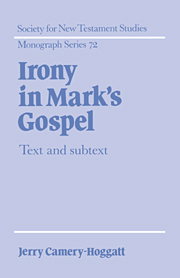Book contents
- Frontmatter
- Contents
- Preface
- List of abbreviations
- 1 Introduction: the problem of irony in Mark
- 2 The social functions of irony
- 3 The literary functions of narrative
- 4 Text and subtext: toward a rhetoric of irony
- 5 The Evidence of Irony in the Gospel of Mark
- 6 By way of summary
- Notes
- Bibliography
- Index
- CITATIONS FROM EXTRA-CANONICAL JEWISH LITERATURE
3 - The literary functions of narrative
Published online by Cambridge University Press: 22 October 2009
- Frontmatter
- Contents
- Preface
- List of abbreviations
- 1 Introduction: the problem of irony in Mark
- 2 The social functions of irony
- 3 The literary functions of narrative
- 4 Text and subtext: toward a rhetoric of irony
- 5 The Evidence of Irony in the Gospel of Mark
- 6 By way of summary
- Notes
- Bibliography
- Index
- CITATIONS FROM EXTRA-CANONICAL JEWISH LITERATURE
Summary
In Chapter 2 I suggested that the telling of stories represents a kind of informal or pre-formal epistemology, a way of structuring and understanding the world which is critical to the establishment of group-boundaries. Here I wish to suggest that the interpretative power of story lies in the fact that it stands removed from the “real” world in significant ways. A relationship exists between brute reality and narrative, but that relationship is never straightforward or simple. It is always manifold and complex. In this chapter we shall concern ourselves with the functions of the narrative's internal elements which make that complex relationship with brute reality possible. The critical term here is “function,” and we shall be using it in a sense which has somewhat different nuances from those in Chapter 2. In our discussion of the social functions of narratives we dealt with the significance of the narrative or its details for the community of the teller and listener. In our discussion of literary functions we shall deal with the relationship of the narrative elements to one another. We might express that difference in other terms: in the sociological study of literature we have explored the role of the narrative elements in orienting the reader within his own world; in literary study we shall explore the role of the narrative elements in orienting the reader within the world of the narrative itself.
- Type
- Chapter
- Information
- Irony in Mark's GospelText and Subtext, pp. 36 - 56Publisher: Cambridge University PressPrint publication year: 1992



